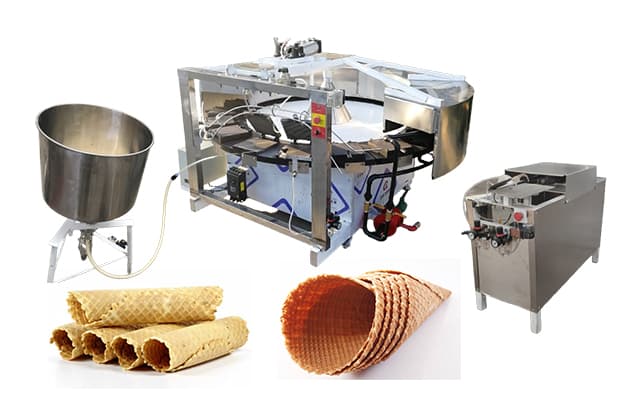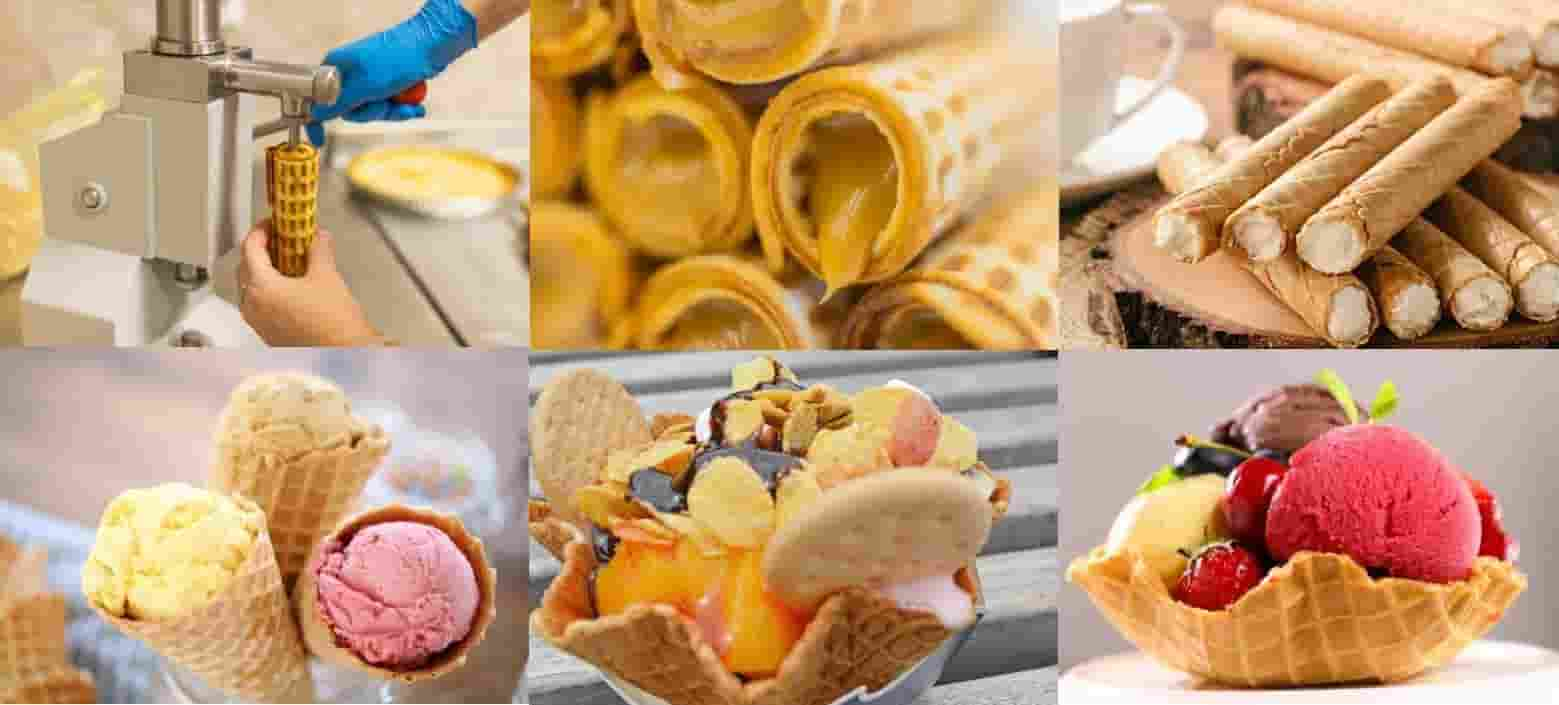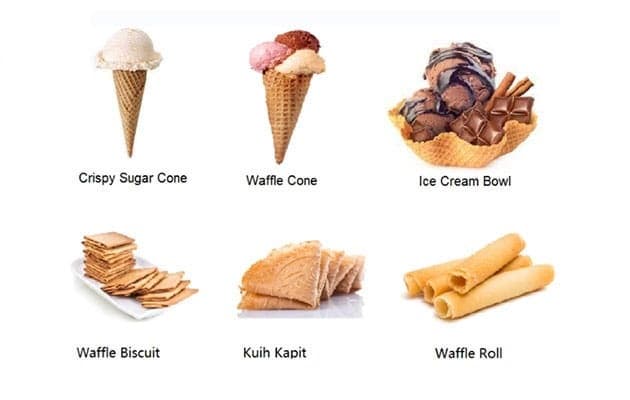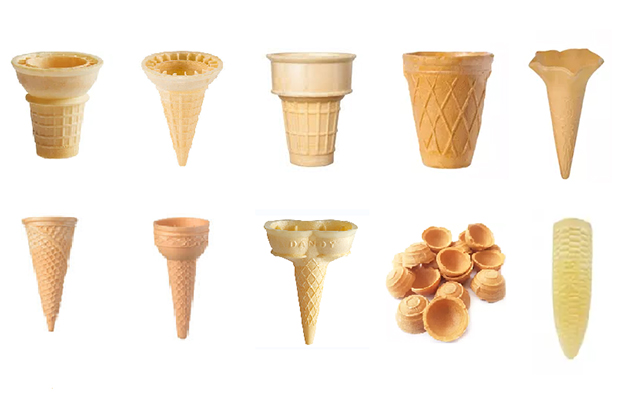Dondurma külahının dokusu, ürün kalitesini ve müşteri memnuniyetini belirleyen en önemli faktörlerden biridir.. Bazı tüketiciler tercih ediyor çıtır waffle külahları tatmin edici bir çıtırtı ile, diğerleri eğlenirken daha yumuşak ve daha esnek koniler Kolayca parçalanmayan.
kullanan üreticiler için otomatik dondurma külahı makineleri, ayarlama formül ve pişirme işlemi doğru şekilde büyük fark yaratabilir. Bu makale malzemelerin nasıl değiştirileceğini açıklayacaktır, sıcaklık, Daha çıtır veya daha yumuşak külahlar üretmek için nem seviyeleri ve nem seviyeleri; tarifinizi mükemmelleştirmenize ve üretim verimliliğinizi artırmanıza yardımcı olur.

1. Dondurma Külahı Dokusunun Bilimini Anlamak
Bir dondurma külahının dokusu temel olarak şunlara bağlıdır: nem içeriği, şeker seviyesi, yağ bileşimi, Ve pişirme koşulları.
Koniler pişirildiğinde, su buharlaşır ve şeker karamelize olur, koninin olup olmayacağını belirleyen bir yapı oluşturmak hafif ve çıtır veya yumuşak ve çiğnenebilir. Formüldeki küçük değişiklikler bile bu dengeyi önemli ölçüde değiştirebilir.
| Faktör | Doku Üzerindeki Etki | Sonuç |
|---|---|---|
| Düşük nem + yüksek pişirme sıcaklığı | Kuru ve gevrek | Çıtır külah |
| Yüksek nem + daha düşük pişirme sıcaklığı | Esnekliği korur | Yumuşak koni |
| Yüksek şeker içeriği | Karamelizasyon ve gevreklik | Daha çıtır |
| Yüksek yağ içeriği | Hassasiyet ve yumuşaklık | Daha yumuşak koni |
Bu ilişkileri anlamak, üreticilerin koni formüllerinde müşteri tercihi ve pazar talebine göre ince ayar yapmalarına yardımcı olur.
2. Temel Dondurma Külahı Formülü
İşte ticari üretim hatlarında kullanılan standart bir temel formül:
| Bileşen | Yüzde (%) | İşlev |
|---|---|---|
| Buğday unu | 45–50 | Yapı sağlar |
| Şeker | 20–25 | Tatlılık, karamelizasyon |
| su | 20–25 | Hidrasyon, buhar |
| Yağ veya tereyağı | 3–5 | Hassasiyet, lezzet |
| Yumurtalar (isteğe bağlı) | 2–3 | Renk ve yapı |
| Tuz | 0.2–0,3 | Lezzeti dengeler |
| Emülgatör (isteğe bağlı) | 0.5 | Dokuyu iyileştirir |
| Karbonat (isteğe bağlı) | 0.2 | Hafiflik katar |
Bu formül bir üretir dengeli koni bu gevrek ama çok kırılgan değil. Bu başlangıç noktasından, İstediğiniz gevreklik veya yumuşaklık seviyesini elde etmek için oranları ayarlayabilirsiniz.

3. Daha Çıtır Dondurma Külahları Nasıl Yapılır
A çıtır külah düşük nem ile karakterize edilir, hafif, ve çıtır bir ısırık. Külahları daha çıtır yapmak için, nemi azaltmaya ve şeker karamelizasyonunu artırmaya odaklanın.
3.1. Su İçeriğini Azaltın
Su içeriğini %5-10 oranında azaltmak daha kuru bir hamur oluşmasına yardımcı olur. Daha az su, pişirme sırasında daha az buhar anlamına gelir, daha çıtır bir doku elde edilmesini sağlar.
3.2. Şekeri veya Şurubu Artırın
Şeker karamelleşmeyi ve kırılgan dokuyu destekler. Şekeri %2-5 oranında artırmak gevrekliği artırır ancak aşırı kızarmayı önlemek için dengelenmelidir.
🔸 İpucu: Rengi ve gevrekliği daha iyi kontrol etmek için ince beyaz şeker veya glikoz şurubu kullanın.
3.3. Pişirme Sıcaklığını Artırın
Pişirme sıcaklığını şu kadar artırın: 10–15°C pişirme süresini biraz kısaltırken. Bu, koninin çabuk kurumasını ve sertleşmesini sağlar.
Tipik pişirme aralığı:
- 180–200°C çıtır külahlar için
- 160–175°C yumuşak koniler için
3.4. Sıvı veya Katı Yağı Azaltın
Yağ yumuşaklığa katkıda bulunur. Yağ içeriğini %1-2 oranında azaltmak koni yapısını daha sert ve çıtır hale getirebilir.
3.5. Mısır Nişastası veya Pirinç Unu Ekleyin
%5-10 mısır nişastası ekleme (buğday ununun bir kısmının değiştirilmesi) gluten oluşumunu azaltarak gevrekliği artırır.
3.6. Uygun Soğutmayı Sağlayın
Pişirmeden sonra, koniler kuru havada hızla soğutulmalıdır. Soğutma sırasındaki nem konileri yumuşatabilir. Bir kullanın soğutma konveyörü veya nem giderici canlılığı korumak için.

4. Daha Yumuşak Dondurma Külahları Nasıl Yapılır
Kalan koniler için esnek ve yumuşak, özellikle konilerin sarılması veya doldurulması için kullanışlıdır, formül ve pişirme işlemi daha fazla nem ve yağ tutmalıdır.
4.1. Su veya Sütü Artırın
%5-10 daha fazla sıvı ekleyin (su veya süt) hamurun hidrasyonunu arttırmak için. Bu, pişirme sırasında nemin buharlaşmasını yavaşlatır.
4.2. Daha Fazla Yağ veya Tereyağı Ekleyin
Yağ içeriğini %1-2 oranında arttırmak yapıyı yumuşatır ve ağızda daha yumuşak bir his verir..
4.3. Pişirme Sıcaklığını Azaltın
Pişirme sıcaklığını yaklaşık 160–170°C pişirme süresini biraz arttırırken. Bu aşırı kurumayı önler.
4.4. Yumurta veya Lesitin Ekle
Yumurtalar ve emülgatörler esnekliği artırır ve kırılganlığı önler. Formüle %1-2 yumurta sıvısı veya lesitin ekleyin.
4.5. Kontrol Soğutma ve Depolama
Daha yumuşak koniler için, aşırı soğumayı önleyin. Bunları bir yerde saklayın nem kontrollü ortam (45–U bağıl nem) aşırı kuruluğu önlemek için.
5. Malzemelerin Doku Üzerindeki Etkisi
| Bileşen | İşlev | Çıtırlık Ayarı | Yumuşaklık Ayarı |
|---|---|---|---|
| su | Nemi kontrol eder | Azaltmak | Arttırmak |
| Şeker | Tatlılık katar & gevreklik | Arttırmak | Biraz azalt |
| Sıvı yağ/Tereyağı | Zenginlik katar & yumuşaklık | Azaltmak | Arttırmak |
| Un | Yapı sağlar | Daha az gluten unu kullanın | Normal un kullanın |
| Mısır nişastası | Gluteni azaltır, çıtırlık katıyor | %5-10 ekle | Azalt veya atla |
| Süt/Yumurta | Esneklik katar | %1–2 ile sınırla | Biraz artırın |
| Pişirme Süresi | Kurumayı etkiler | Kısa & sıcak | Uzun & Düşük |
| Soğutma | Nem tutmayı etkiler | Hızlı soğutma | Kontrollü soğutma |
Bu değişkenleri sistematik olarak ayarlayarak, koninin dokusunu her türlü pazar gereksinimine göre uyarlayabilirsiniz; sert waffle külahları, haddelenmiş koniler, veya yumuşak gofret tarzı koniler.

6. Koni Dokusunu Etkileyen Çevresel Faktörler
Hatta aynı formülle, çevre nihai ürünü etkileyebilir:
6.1. Nem
Koniler havadaki nemi kolayca emer. Üretim ve depolama alanlarını aşağıda tutun 50% bağıl nem.
6.2. Depolama Sıcaklığı
İdeal saklama sıcaklığı: 20–25°C. Aşırı ısı konileri yumuşatır, soğuk onları kırılgan hale getirirken.
6.3. Ambalajlama
Kullanmak neme dayanıklı lamine film gevrekliği korumak ve taşıma sırasında yumuşamayı önlemek için.
6.4. Soğutma sistemi
Bir otomatik soğutma konveyörü Koni üretim hattınıza takılması, ambalajlamadan önce dokuyu stabilize etmeye yardımcı olur.
7. Doku Kontrolü için Pişirme Makinesi Ayarları
Modern otomatik dondurma külahı makineleri İstenilen dokuyu elde etmek için pişirme koşullarının hassas kontrolüne olanak tanır.
| Ayar | Daha Çıtır Külah | Daha Yumuşak Koni |
|---|---|---|
| Sıcaklık | 180–200°C | 160–170°C |
| Pişirme Süresi | 90–120 saniye | 130–160 saniye |
| Plaka Basıncı | Orta-yüksek | Düşük-orta |
| Soğutma Havası Akışı | Güçlü | Ilıman |
| Kalıptan Çıkarma Süresi | Hızlı | Hafif gecikme |
💡 Uç: Tutarlı kalite için sıcaklık ve zamanlama ayarlarını otomatikleştirmek amacıyla PLC kontrollü sistemleri kullanın.

8. Koniler için Kalite Testi
Üretimden Sonra, Tutarlılığı korumak için koni dokusunu düzenli olarak test edin:
- Nem Testi – Gevrek külahlar için ideal nem: altında 3%
- Sertlik Testi – Kopma kuvvetini ölçmek için bir doku analizörü kullanın
- Renk Tekdüzeliği – Altın kahverengi uygun karamelizasyonu gösterir
- Tat ve Aroma – Yanmış veya çiğ un kokusu yok
- Depolama Kararlılığı – Çıtırlığın korunmasını 48-72 saat sonra test edin
Tutarlı kalite kontrolü, her partinin markanızın doku standartlarını karşılamasını sağlar.
9. Yaygın Sorunlar ve Çözümler
| Sorun | Olası Neden | Çözüm |
|---|---|---|
| Koniler çok yumuşak | Çok fazla su veya düşük pişirme sıcaklığı | Sıvıyı azaltın, sıcaklığı yükseltmek |
| Koniler çok sert | Az yağlı veya düşük nem | Daha fazla yağ ekleyin veya pişirme süresini kısaltın |
| Düzensiz renk | Düzensiz ısıtma | Isıtma plakalarını veya termostatı kontrol edin |
| Koniler kolayca çatlar | Düşük elastikiyet veya aşırı pişirme | Yumurta ekle, sıcaklığı azalt |
| Yapışkan koniler | Az pişmiş veya fazla şeker | Pişirme süresini biraz uzatın |
Bu ayrıntıları izlemek, istikrarlı üretim elde etmenize ve israfı azaltmanıza yardımcı olabilir.

10. Neden DT Food Machine ile Çalışmalısınız?
DT Food Machine Co., Ltd.. profesyonel bir üreticisidir otomatik dondurma külahı üretim hatları, hamur karıştırmadan pişirme ve paketlemeye kadar eksiksiz çözümler sunuyor.
Avantajlarımız:
- Üzerinde 15 yıllar koni imalat ekipmanlarında deneyim
- Uygun makineler farklı koni şekilleri (şeker konisi, gözleme konisi, gofret konisi, haddelenmiş koni)
- Paslanmaz çelik yapı Hijyen ve dayanıklılık için
- PLC kontrol sistemi hassas formül ve doku ayarı için
- Enerji tasarruflu tasarım düşük işletme maliyeti ile
- Birden fazla ülkeye ihraç edildi 60 ülkeler dünya çapında
İster çıtır waffle külahları, ister yumuşak gofret külahları üretin, DT Food Machine ihtiyaçlarınıza göre doğru üretim hattını özelleştirebilir.
11. Daha Çıtır veya Daha Yumuşak Külahlar İçin Formül Nasıl Ayarlanır?
Mükemmel dondurma külahları üretmenin sırrı, malzemeler arasındaki hassas dengeyi anlamakta yatmaktadır., nem, ve pişirme. Formülünüzü ayarlayarak (gevreklik için suyu azaltarak veya yumuşaklık için yağ ekleyerek) farklı pazarlara uyacak şekilde son dokuyu kontrol edebilirsiniz..
yardımıyla otomatik koni makineleri ve doğru formülasyon bilgisi, Müşterileri memnun eden ve marka itibarınızı güçlendiren külahları sürekli olarak üretebilirsiniz.
Koni üretiminizi optimize etmek veya tam otomatik bir hatta geçmek istiyorsanız, DT Gıda Makinesi tutarlı kaliteye ulaşmada güvenilir ortağınızdır, yeterlik, ve karlılık.

